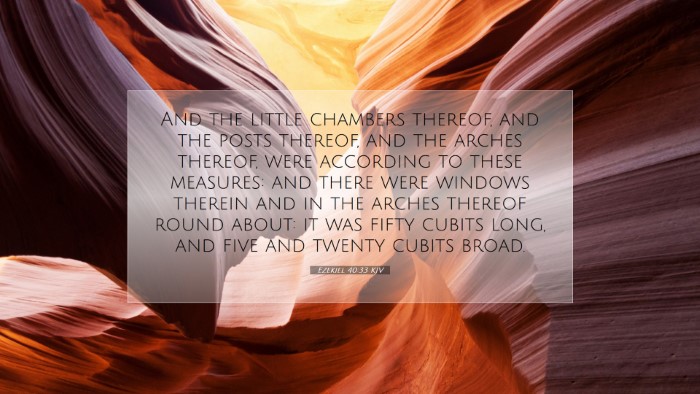Ezekiel 40:33 - Commentary Overview
Ezekiel 40:33 states: "And the little chambers thereof were three on this side, and three on that side: they were three scores and ten in number, and there were eight and twenty pillars upon the little chambers." This verse is part of a larger vision where Ezekiel describes the future temple, its layout, and its significance for Israel. The intricacies of this passage reveal much about God’s intentions for His people and their worship.
Contextual Analysis
The chapter falls within a prophetic vision that Ezekiel received regarding the new temple. This vision not only provided hope for the exiled Israelites but also a detailed description that serves to underline the significance of God’s presence among His people.
Matters of Structure and Symbolism
The mention of little chambers is significant in that it illustrates the architectural complexity of the temple. These were likely used for various purposes including places for priests and for offerings.
- Three on Each Side: This symmetry signifies order and balance, reflecting the divine nature of God and His plans for the temple.
- Three Score and Ten: The number seventy often carries the connotation of completeness and divine order within the Scriptures.
- Twenty-eight Pillars: Pillars represent strength and stability, indicating that this temple will be a stronghold for the worship of Israel.
Insights from Commentators
Matthew Henry's Commentary
Matthew Henry points out the spiritual implications of these chambers, highlighting that they represent spaces for mediation between God and man. He notes how each structure within the temple serves a purpose in bringing Israel closer to God, enhancing their worship and understanding of divine majesty.
Albert Barnes' Notes
Barnes emphasizes the functionality of the chambers described in the passage. He describes their use in relation to the priestly duties and sacrifices, illustrating that every aspect of the temple’s design is deliberate. He posits that their existence fulfills the needs of worship, allowing for a structured approach to the sacrificial system ordained by God.
Adam Clarke's Commentary
Adam Clarke elaborates on the architectural symbolism present in the text. He indicates that the structural elements, such as the chambers and pillars, are emblematic not only of physical spaces but also reflect the spiritual foundation of Israelite worship. Clarke emphasizes that each chamber serves as a reminder of God’s provision and the order that He brings into the worship experience.
Theological Significance
The description of the temple in Ezekiel has profound theological implications. It emphasizes holiness, order, and the divine encounter:
- God’s Presence: The detailed design speaks to God’s desire to dwell among His people. Each chamber is a reminder of the sanctity needed for God to inhabit their midst.
- The Nature of Worship: The chambers facilitate the roles of the priests, underscoring the importance of mediators in approaching God, a theme echoed throughout biblical history.
- Promise of Restoration: For the exiles, this vision of a new temple represents hope, a reaffirmation of God’s covenant with Israel, promising restoration and renewal.
Conclusion
Ezekiel 40:33 serves as a reminder of the intimate relationship between God and His people. The elaborate description of the temple's architecture not only illustrates the physical space for worship but also conveys deeper spiritual truths about access to God, the importance of order in worship, and the hope of restoration. It invites pastors, students, theologians, and scholars alike to explore these themes further, drawing lessons for contemporary faith practices.


